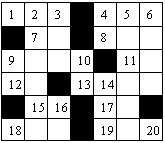poj 1888 Crossword Answers 模拟题
| Time Limit: 1000MS | Memory Limit: 30000K | |
| Total Submissions: 869 | Accepted: 405 |
Description
One list of definitions is for ``words" to be written left to right across white squares in the rows and the other list is for words to be written down white squares in the columns. (A word is a sequence of alphabetic characters.)
To solve a crossword puzzle, one writes the words corresponding to the definitions on the white squares of the grid.
The definitions correspond to the rectangular grid by means of sequential integers on ``eligible" white squares. White squares with black squares immediately to the left or above them are ``eligible." White squares with no squares either immediately to the left or above are also ``eligible." No other squares are numbered. All of the squares on the first row are numbered.
The numbering starts with 1 and continues consecutively across white squares of the first row, then across the eligible white squares of the second row, then across the eligible white squares of the third row and so on across all of the rest of the rows of the puzzle. The picture below illustrates a rectangular crossword puzzle grid with appropriate numbering. 
An "across" word for a definition is written on a sequence of white squares in a row starting on a numbered square that does not follow another white square in the same row. The sequence of white squares for that word goes across the row of the numbered square, ending immediately before the next black square in the row or in the rightmost square of the row.
A "down" word for a definition is written on a sequence of white squares in a column starting on a numbered square that does not follow another white square in the same column. The sequence of white squares for that word goes down the column of the numbered square, ending immediately before the next black square in the column or in the bottom square of the column. Every white square in a correctly solved puzzle contains a letter.
You must write a program that takes several solved crossword puzzles as input and outputs the lists of across and down words which constitute the solutions.
Input
Output
Sample Input
2 2
AT
*O
6 7
AIM*DEN
*ME*ONE
UPON*TO
SO*ERIN
*SA*OR*
IES*DEA
0
Sample Output
puzzle #1:
Across
1.AT
3.O
Down
1.A
2.TO puzzle #2:
Across
1.AIM
4.DEN
7.ME
8.ONE
9.UPON
11.TO
12.SO
13.ERIN
15.SA
17.OR
18.IES
19.DEA
Down
1.A
2.IMPOSE
3.MEO
4.DO
5.ENTIRE
6.NEON
9.US
10.NE
14.ROD
16.AS
18.I
20.A
这是一道字符串模拟题。给你一个字符矩阵,让你水平读,竖直读。遇到'*'或者换行,就输出读取的字符串,至于编号,则是第一行和第一列非‘*’的都要标号,其他的若该字符不是‘*’并且其前一个或是上一个字符若为‘*’则将其编号。
下面是我的代码:
#include <iostream>
#include <iomanip>
using namespace std;
char ch[][];
int ch1[][]; int main()
{
int r,c,i,j,k,m,puzzle=;
while(cin>>r && r)
{
cin>>c;
memset(ch1,,sizeof(ch1));
for(i=; i<r; i++)
for(j=; j<c; j++)
cin>>ch[i][j];
m = ;
for(i=; i<r; i++) //对字符进行编号
for(j=; j<c; j++)
{
if(i== || j==)
{
if(ch[i][j] != '*')
ch1[i][j] = m++;
}
else
{
if(ch[i][j] != '*')
if(ch[i-][j]=='*' || ch[i][j-]=='*')
ch1[i][j] = m++;
}
}
cout<<"puzzle #"<<puzzle++<<":"<<endl;
cout<<"Across"<<endl;
{
for(i=; i<r; i++)
for(j=; j<c; j++)
{
if(ch[i][j]!='*')
{
cout<<setw()<<ch1[i][j]<<"."<<ch[i][j];
j++;
while(j<c && ch[i][j]!='*')
cout<<ch[i][j++];
j--;
cout<<endl;
}
}
}
cout<<"Down"<<endl;
{
for(i=; i<r; i++)
{ for(j=; j<c; j++)
{
k=i;
if(ch[k][j]!='*')
{
cout<<setw()<<ch1[k][j]<<"."<<ch[k][j];
ch[k][j] = '*';
k++;
while(k<r && ch[k][j]!='*')
{
cout<<ch[k][j];
ch[k][j] = '*';
k++;
}
k--;
cout<<endl;
}
}
}
}
cout<<endl;
}
return ;
}
poj 1888 Crossword Answers 模拟题的更多相关文章
- POJ - 1835 宇航员(模拟题)
问题描述: 宇航员在太空中迷失了方向,在他的起始位置现在建立一个虚拟xyz坐标系,称为绝对坐标系,宇航员正面的方向为x轴正方向,头顶方向为z轴正方向,则宇航员的初始状态如下图所示: 现对六个方向分别标 ...
- POJ 2348 Euclid Game (模拟题)
Euclid's Game Time Limit: 1000MS Memory Limit: 65536K Total Submissions: 7942 Accepted: 3227 Des ...
- poj 1008:Maya Calendar(模拟题,玛雅日历转换)
Maya Calendar Time Limit: 1000MS Memory Limit: 10000K Total Submissions: 64795 Accepted: 19978 D ...
- POJ 3393 Lucky and Good Months by Gregorian Calendar 模拟题
题目:http://poj.org/problem?id=3393 不多说了,简单模拟题,因为粗心写错了两个字母,导致错了N遍,模拟还是一贯的恶心,代码实在不想优化了,写的难看了点.. #includ ...
- POJ 模拟题集合
http://www.cppblog.com/Uriel/articles/101592.html 感觉这个暑假没有去年有激情啊,,,还没到状态就已经块上学了,,, 真是弱暴了,,,找几道模拟题刷刷. ...
- POJ 3923 Ugly Windows(——考察思维缜密性的模拟题)
题目链接: http://poj.org/problem?id=3923 题意描述: 输入一个n*m的屏幕 该屏幕内有至少一个对话框(每个对话框都有对应的字母表示) 判断并输出该屏幕内处于最表层的对话 ...
- POJ 1008 简单模拟题
e.... 虽然这是一道灰常简单的模拟题.但是米做的时候没有读懂第二个日历的计时方法.然后捏.敲完之后华丽的WA了进一个点.坑点就在一年的最后一天你是该输出本年的.e ...但是我好想并没有..看di ...
- UVa232.Crossword Answers
题目链接:http://uva.onlinejudge.org/index.php?option=com_onlinejudge&Itemid=8&page=show_problem& ...
- Codeforces 767B. The Queue 模拟题
B. The Queue time limit per test:1 second memory limit per test:256 megabytes input:standard input o ...
随机推荐
- db2日常维护
一. DB2日常维护操作 1.数据库的启动.停止.激活 db2 list active databases db2 active db 数据库名 db2start --启动 db2stop [forc ...
- 11877 The Coco-Cola Store
题目: 11877 The Coco-Cola Store Once upon a time, there is a special coco-cola store. If you retur ...
- Android基于XMPP的即时通讯3-表情发送
这篇博文主要讲表情发送的一些东西. 参考:Android基于XMPP的即时通讯1-基本对话 1.准备好资源文件 采用的是emoji的表情,我打包好了,下载地址:http://files.cnblogs ...
- C++ substr() 和 Java substring() 区别
Java和C++中都有关于子字符串的操作,C++中是substr(),Java中是substring(),两者的用法上稍有些区别,首先针对只有一个参数的情况: s.substr(start) 和 s. ...
- Hibernate---单条记录的增删改查
package com.hanqi.test; import static org.junit.Assert.*; import java.util.Date; import org.hibernat ...
- getPos封装
<!DOCTYPE HTML> <html> <head> <meta http-equiv="Content-Type" content ...
- html5用到的js
1.Zepto.js 是专门为现代智能手机浏览器退出的 Javascript 框架, 拥有和jQuery相似的语法, 但是和jQuery相比下来, 他有很多优点, 大小方面 , 压缩后的 zepto. ...
- HTML5初学篇章_3
表单的标签是<form>,它使页面与客户的互动成为可能.而它的大部分元素字自HTML2.0后就没有再改变过,由此可见这是一个多么具有卓越性的设计. <form>标签是用于创建供 ...
- Maven下载安装
1.maven下载地址 https://maven.apache.org/配置:M2_HOME D:\tool\mvn\apache-maven-3.3.9 PATH %M2_HOME%/bin3.命 ...
- SpringMvc输入地址报错
出现上面的错误如果不是路径的问题,就应该找环境的问题,我这里的问题是tomcat7+jdk6,应该是jdk7或以后的版本(因为是web socket) 对应的版本http://tomcat.apach ...
